Publications
A full list of publications is also available on my Google Scholar.
Submitted / Under Review
2025
- Human Influence on the Ozone Layer Detectable by the 1960sJian Guan, Benjamin D. Santer, Peidong Wang, Qiang Fu, Rolando R. Garcia, Yaowei Li, Kane Stone, and 5 more authorsProceedings of the National Academy of Sciences (under review), 2025
- Ocean Outgassing of Methyl Chloroform as an Underestimated Source of EmissionPeidong Wang, Susan Solomon, Jeffery R. Scott, Shari A. Yvon‑Lewis, Paul O. Wennberg, Ray F Weiss, Matt Rigby, and 1 more authorGeophysical Research Letters (under review), 2025
Methyl chloroform (MCF) is a synthetic ozone-depleting substance used as an industrial solvent. Its primary sink is reaction with the hydroxyl radical (OH), making it a key tracer for estimating atmospheric oxidative capacity. Following Montreal Protocol regulations, MCF emissions declined rapidly after the 1990s. However, the recent slowdown in atmospheric MCF decay suggests persistent emissions and/or declining OH (contradicting chemistry-climate models projecting increasing OH). The air-sea exchange of MCF has been poorly constrained due to limited observations and simplified ocean representations. We simulate oceanic MCF fluxes using a modern ocean reanalysis and validate with depth-resolved observations. Results suggest the ocean has shifted from a net sink to a net source around 2005, outgassing 0.5 Gg yr-1 in the 2010s (up to 30% of inferred MCF emissions). This ocean outgas is an order of magnitude larger than previous estimates and can have important implications for interpreting OH levels from MCF records.
Peer-reviewed
2025
- AGU Adv.
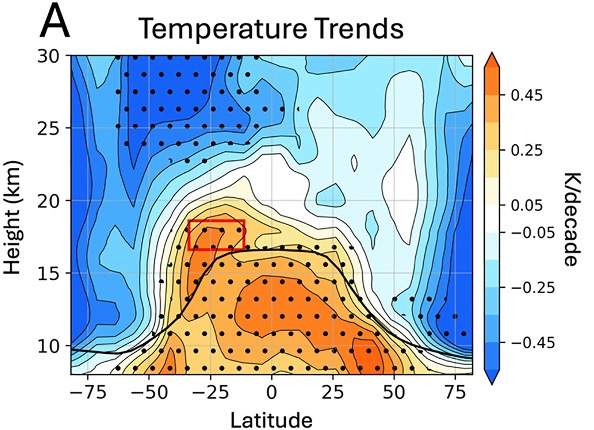 Recent Warming of the Southern Hemisphere Subtropical Lower Stratosphere and Antarctic Ozone HealingAodhan Sweeney, Qiang Fu, Susan Solomon, Stephen Po-Chedley, William J. Randel, Andrea Steiner, Pu Lin, and 3 more authorsAGU Advances, 2025
Recent Warming of the Southern Hemisphere Subtropical Lower Stratosphere and Antarctic Ozone HealingAodhan Sweeney, Qiang Fu, Susan Solomon, Stephen Po-Chedley, William J. Randel, Andrea Steiner, Pu Lin, and 3 more authorsAGU Advances, 2025Observed temperature changes from 2002 to 2022 reveal a pronounced warming of the Southern Hemisphere (SH) subtropical lower stratosphere, and a cooling of the Antarctic lower stratosphere. In contrast, model simulations of 21st-century stratospheric temperature changes show widespread cooling driven by increasing greenhouse gases, with local warming in the Antarctic lower stratosphere due to ozone healing. We provide evidence that these discrepancies between observed and simulated stratospheric temperature changes are linked to a slowdown of the Brewer-Dobson Circulation, particularly in the SH. These changes in the stratospheric circulation are strongest from October through December. This altered circulation warms the SH subtropical lower stratosphere while cooling the Antarctic lower stratosphere, canceling and even reversing the Antarctic ozone recovery that would have occurred in its absence during this period. When circulation changes are accounted for, the SH subtropical lower-stratospheric warming is removed, and Antarctic lower-stratospheric warming is revealed with enhanced ozone healing, highlighting the crucial role of the stratospheric circulation in shaping temperature and ozone changes.
@article{sweeney_recent_2025, title = {Recent {Warming} of the {Southern} {Hemisphere} {Subtropical} {Lower} {Stratosphere} and {Antarctic} {Ozone} {Healing}}, volume = {6}, issn = {2576-604X}, number = {4}, journal = {AGU Advances}, author = {Sweeney, Aodhan and Fu, Qiang and Solomon, Susan and Po-Chedley, Stephen and Randel, William J. and Steiner, Andrea and Lin, Pu and Birner, Thomas and Davis, Sean and Wang, Peidong}, year = {2025}, } - Nature
 Fingerprinting the recovery of Antarctic ozonePeidong Wang, Susan Solomon, Benjamin D. Santer, Douglas E. Kinnison, Qiang Fu, Kane A. Stone, Jun Zhang, and 2 more authorsNature, 2025
Fingerprinting the recovery of Antarctic ozonePeidong Wang, Susan Solomon, Benjamin D. Santer, Douglas E. Kinnison, Qiang Fu, Kane A. Stone, Jun Zhang, and 2 more authorsNature, 2025The Antarctic ozone ‘hole’ was discovered in 1985 and man-made ozone-depleting substances (ODSs) are its primary cause. Following reductions of ODSs under the Montreal Protocol, signs of ozone recovery have been reported, based largely on observations and broad yet compelling model–data comparisons. Although such approaches are highly valuable, they do not provide rigorous statistical detection of the temporal and spatial structure of Antarctic ozone recovery in the presence of internal climate variability. Here we apply pattern-based detection and attribution methods as used in climate-change studies to separate anthropogenically forced ozone responses from internal variability, relying on trend pattern information as a function of month and height. The analysis uses satellite observations together with single-model and multi-model ensemble simulations to identify and quantify the month–height Antarctic ozone recovery ‘fingerprint’. We demonstrate that the data and simulations show compelling agreement in the fingerprint pattern of the ozone response to decreasing ODSs since 2005. We also show that ODS forcing has enhanced ozone internal variability during the austral spring, influencing detection of forced responses and their time of emergence. Our results provide robust statistical and physical evidence that actions taken under the Montreal Protocol to reduce ODSs are indeed resulting in the beginning of Antarctic ozone recovery, defined as increases in ozone consistent with expected month–height patterns.
@article{wang_fingerprinting_2025, title = {Fingerprinting the recovery of {Antarctic} ozone}, volume = {639}, issn = {1476-4687}, number = {8055}, journal = {Nature}, author = {Wang, Peidong and Solomon, Susan and Santer, Benjamin D. and Kinnison, Douglas E. and Fu, Qiang and Stone, Kane A. and Zhang, Jun and Manney, Gloria L. and Millán, Luis F.}, year = {2025}, pages = {646--651}, }
2024
- GRL
 Contrasting Chlorine Chemistry on Volcanic and Wildfire Aerosols in the Southern Mid-Latitude Lower StratospherePeidong Wang and Susan SolomonGeophysical Research Letters, 2024
Contrasting Chlorine Chemistry on Volcanic and Wildfire Aerosols in the Southern Mid-Latitude Lower StratospherePeidong Wang and Susan SolomonGeophysical Research Letters, 2024Abstract Volcanic eruptions and wildfires can impact stratospheric chemistry. We apply tracer-tracer correlations to satellite data from Atmospheric Chemistry Experiment—Fourier Transform Spectrometer and the Halogen Occultation Experiment at 68 hPa to consistently compare the chemical impact on HCl after multiple wildfires and volcanic eruptions of different magnitudes. The 2020 Australian New Year (ANY) fire displayed an order of magnitude less stratospheric aerosol extinction than the 1991 Pinatubo eruption, but showed similar large changes in mid-latitude lower stratosphere HCl. While the mid-latitude aerosol loadings from the 2015 Calbuco and 2022 Hunga volcanic eruptions were similar to the ANY fire, little impact on HCl occurred. The 2009 Australian Black Saturday fire and 2021 smoke remaining from 2020 yield small HCl changes, at the edge of the detection method. These observed contrasts across events highlight greater reactivity for smoke versus volcanic aerosols at warm temperatures.
@article{wang_contrasting_2024, title = {Contrasting {Chlorine} {Chemistry} on {Volcanic} and {Wildfire} {Aerosols} in the {Southern} {Mid}-{Latitude} {Lower} {Stratosphere}}, volume = {51}, number = {18}, journal = {Geophysical Research Letters}, author = {Wang, Peidong and Solomon, Susan}, year = {2024}, keywords = {wildfire, stratospheric chemistry, volcanic eruption, satellite}, pages = {e2024GL110412}, } - GRL
 Stratospheric Chlorine Processing After the Unprecedented Hunga Tonga EruptionJun Zhang, Peidong Wang, Douglas Kinnison, Susan Solomon, Jian Guan, Kane Stone, and Yunqian ZhuGeophysical Research Letters, 2024
Stratospheric Chlorine Processing After the Unprecedented Hunga Tonga EruptionJun Zhang, Peidong Wang, Douglas Kinnison, Susan Solomon, Jian Guan, Kane Stone, and Yunqian ZhuGeophysical Research Letters, 2024Abstract Following the Hunga Tonga?Hunga Ha’apai (HTHH) eruption in January 2022, significant reductions in stratospheric hydrochloric acid (HCl) were observed in the Southern Hemisphere mid-latitudes during the latter half of 2022, suggesting potential chlorine activation. The objective of this study is to comprehensively understand the loss of HCl in the aftermath of HTHH. Satellite measurements and a global chemistry-climate model are employed for the analysis. We find strong agreement of 2022 anomalies between the modeled and the measured data. The observed tracer-tracer relations between nitrous oxide (N2O) and HCl indicate a significant role of chemical processing in the observed HCl reduction, especially during the austral winter of 2022. Further examining the roles of chlorine gas-phase and heterogeneous chemistry, we find that heterogeneous chemistry emerges as the primary driver for the chemical loss of HCl, and the reaction between hypobromous acid (HOBr) and HCl on sulfate aerosols is the dominant loss process.
@article{zhang_stratospheric_2024, title = {Stratospheric {Chlorine} {Processing} {After} the {Unprecedented} {Hunga} {Tonga} {Eruption}}, volume = {51}, issn = {0094-8276}, number = {17}, urldate = {2025-06-05}, journal = {Geophysical Research Letters}, author = {Zhang, Jun and Wang, Peidong and Kinnison, Douglas and Solomon, Susan and Guan, Jian and Stone, Kane and Zhu, Yunqian}, year = {2024}, pages = {e2024GL108649}, }
2023
- GRL
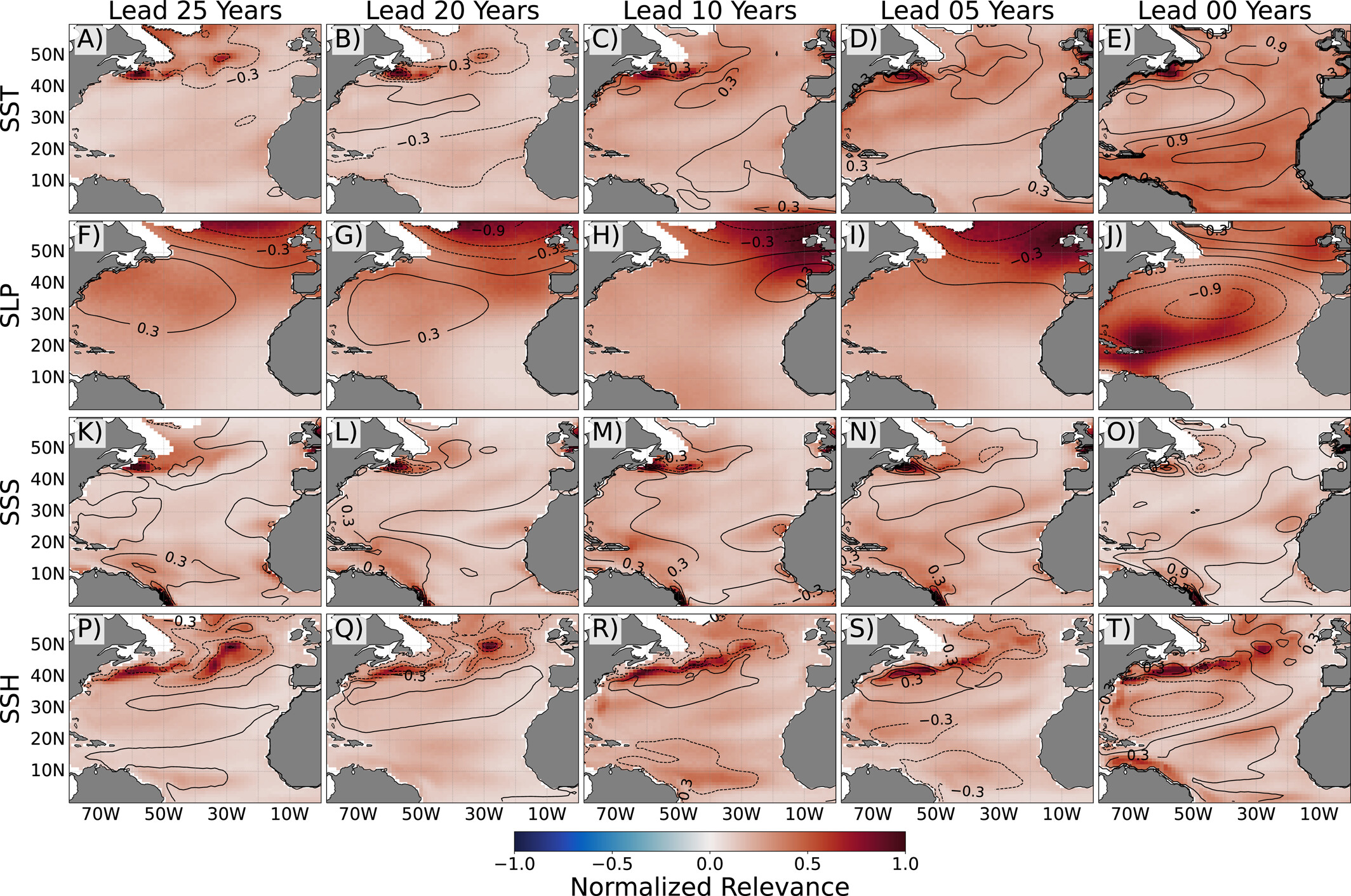 Physical Insights From the Multidecadal Prediction of North Atlantic Sea Surface Temperature Variability Using Explainable Neural NetworksGlenn Liu, Peidong Wang, and Young-Oh KwonGeophysical Research Letters, 2023
Physical Insights From the Multidecadal Prediction of North Atlantic Sea Surface Temperature Variability Using Explainable Neural NetworksGlenn Liu, Peidong Wang, and Young-Oh KwonGeophysical Research Letters, 2023Abstract North Atlantic sea surface temperatures (NASST), particularly in the subpolar region, are among the most predictable in the world’s oceans. However, the relative importance of atmospheric and oceanic controls on their variability at multidecadal timescales remain uncertain. Neural networks (NNs) are trained to examine the relative importance of oceanic and atmospheric predictors in predicting the NASST state in the Community Earth System Model 1 (CESM1). In the presence of external forcings, oceanic predictors outperform atmospheric predictors, persistence, and random chance baselines out to 25-year leadtimes. Layer-wise relevance propagation is used to unveil the sources of predictability, and reveal that NNs consistently rely upon the Gulf Stream-North Atlantic Current region for accurate predictions. Additionally, CESM1-trained NNs successfully predict the phasing of multidecadal variability in an observational data set, suggesting consistency in physical processes driving NASST variability between CESM1 and observations.
@article{liu_physical_2023, title = {Physical {Insights} {From} the {Multidecadal} {Prediction} of {North} {Atlantic} {Sea} {Surface} {Temperature} {Variability} {Using} {Explainable} {Neural} {Networks}}, volume = {50}, issn = {0094-8276}, number = {24}, urldate = {2024-08-17}, journal = {Geophysical Research Letters}, author = {Liu, Glenn and Wang, Peidong and Kwon, Young-Oh}, year = {2023}, pages = {e2023GL106278}, } - GRL
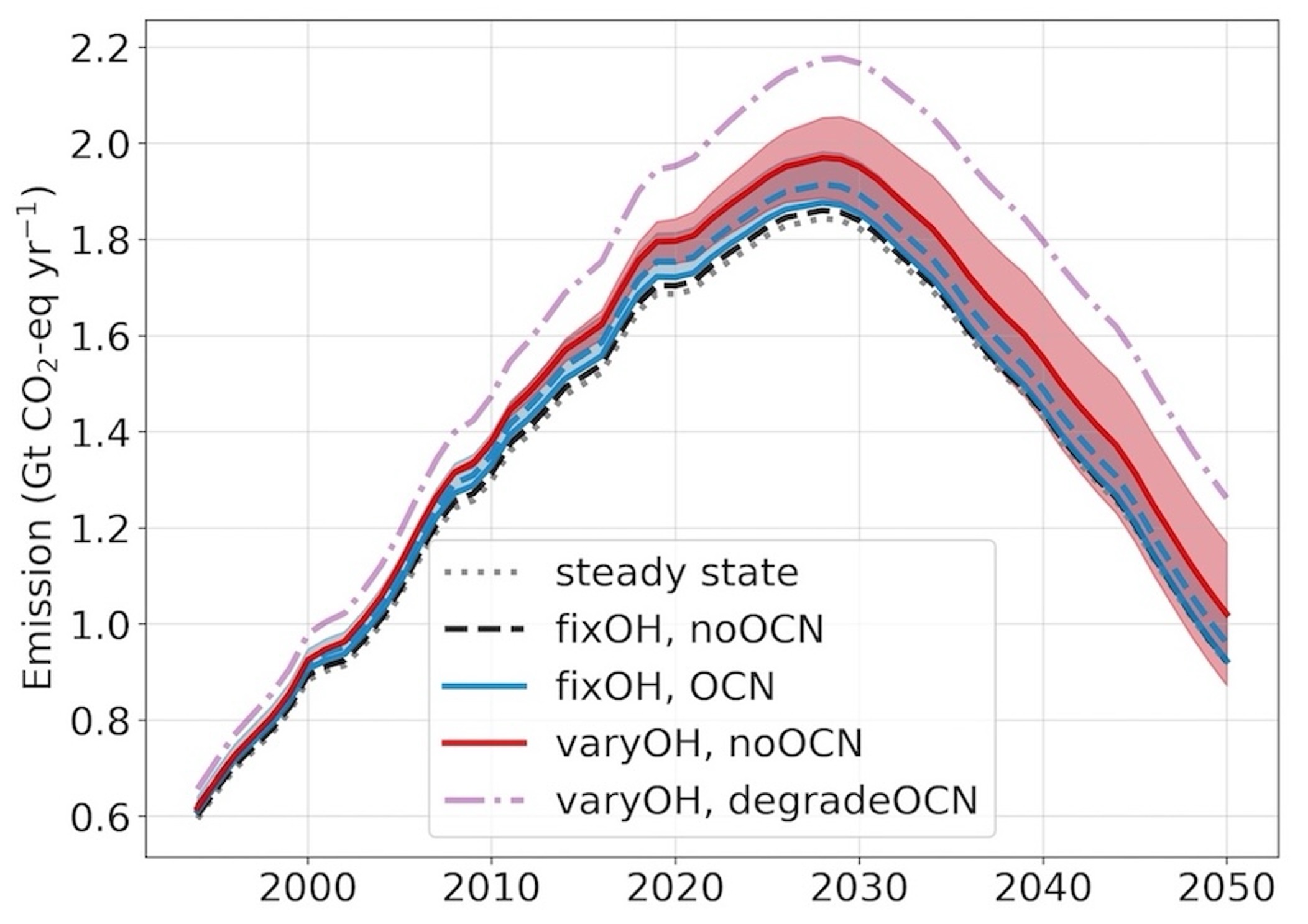 On the Influence of Hydroxyl Radical Changes and Ocean Sinks on Estimated HCFC and HFC Emissions and BanksPeidong Wang, Susan Solomon, Megan Lickley, Jeffery R. Scott, Ray F. Weiss, and Ronald G. PrinnGeophysical Research Letters, 2023
On the Influence of Hydroxyl Radical Changes and Ocean Sinks on Estimated HCFC and HFC Emissions and BanksPeidong Wang, Susan Solomon, Megan Lickley, Jeffery R. Scott, Ray F. Weiss, and Ronald G. PrinnGeophysical Research Letters, 2023Abstract Hydrochlorofluorocarbons (HCFCs) and hydrofluorocarbons (HFCs) are potent greenhouse gases regulated under the Montreal Protocol and its amendments. Emission estimates generally use constant atmospheric lifetimes accounting for loss via hydroxyl radical (OH) reactions. However, chemistry-climate models suggest OH increases after 1980, implying underestimated emissions. Further, HCFCs and HFCs are soluble in seawater and could be destroyed through in situ oceanic microbial activity. These ocean sinks are largely overlooked. Using a coupled atmosphere-ocean model, we show that increases in modeled OH imply underestimated HCFC and HFC emissions by 10% near their respective peak emissions. Our model results also suggest that oceanic processes could lead to up to an additional 10% underestimation in these halocarbon emissions in the 2020s. Ensuring global compliance to the Protocol and accurate knowledge of contributions to global warming from these gases therefore requires understanding of these processes.
@article{wang_influence_2023, title = {On the {Influence} of {Hydroxyl} {Radical} {Changes} and {Ocean} {Sinks} on {Estimated} {HCFC} and {HFC} {Emissions} and {Banks}}, volume = {50}, issn = {0094-8276}, number = {18}, urldate = {2024-08-17}, journal = {Geophysical Research Letters}, author = {Wang, Peidong and Solomon, Susan and Lickley, Megan and Scott, Jeffery R. and Weiss, Ray F. and Prinn, Ronald G.}, year = {2023}, pages = {e2023GL105472}, } - PNAS
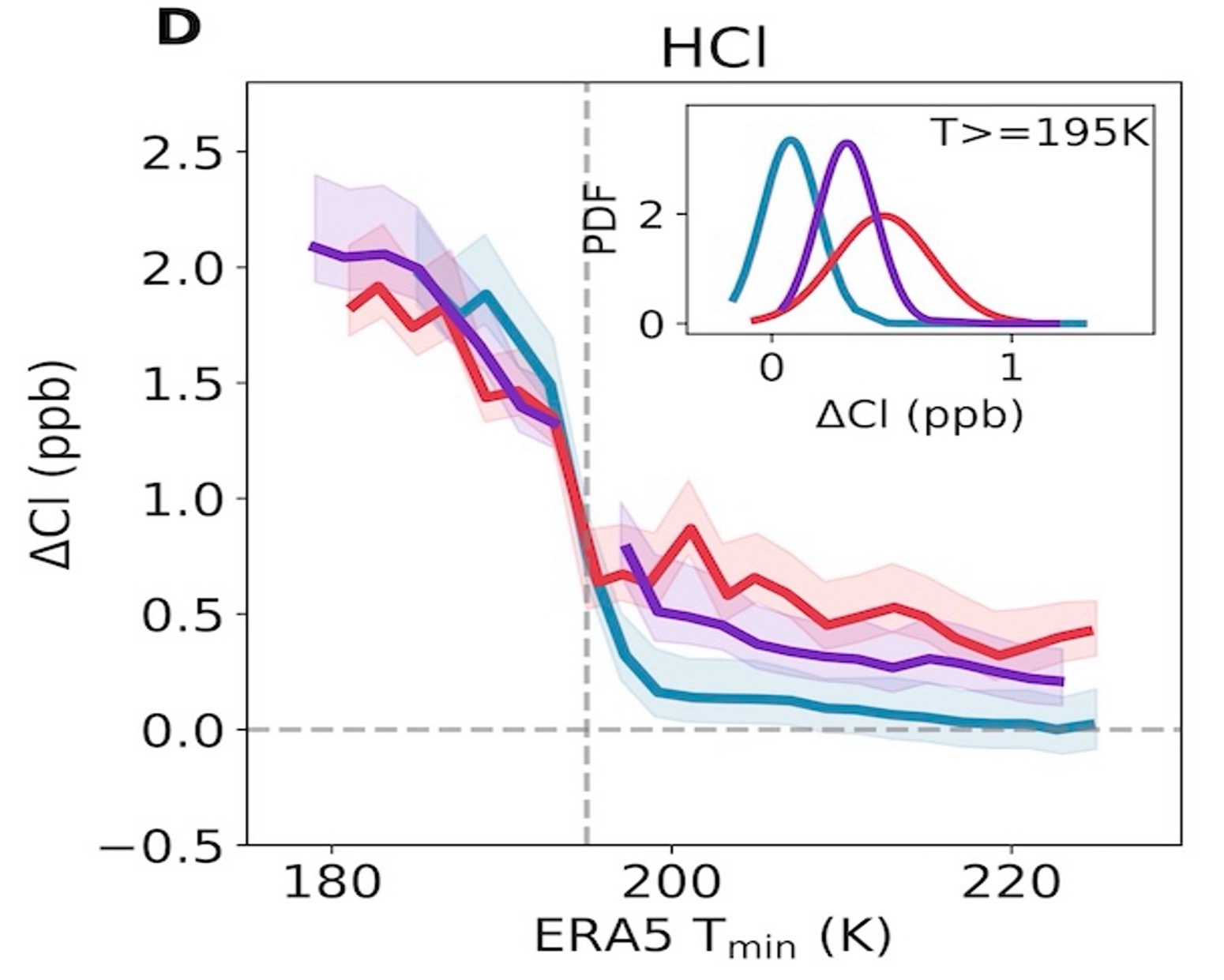 Stratospheric chlorine processing after the 2020 Australian wildfires derived from satellite dataPeidong Wang, Susan Solomon, and Kane StoneProceedings of the National Academy of Sciences, 2023
Stratospheric chlorine processing after the 2020 Australian wildfires derived from satellite dataPeidong Wang, Susan Solomon, and Kane StoneProceedings of the National Academy of Sciences, 2023Heterogeneous chlorine activation is a major driver for stratospheric ozone depletion and is understood to happen on polar stratospheric clouds (PSCs) at temperatures below about 195 K. The 2020 Australian wildfire released large amounts of organic aerosols, whose chemical properties under stratospheric conditions are virtually unknown. Here, we developed an approach to analyze the temperature dependency of atmospheric chlorine heterogeneous chemistry using satellite data. We found that such reactions can happen at temperatures even at 220 K on wildfire aerosols in 2020. Organic aerosols are present to some degree in the lower stratosphere even under background conditions. This result indicates that Cl processes on organic aerosols likely need to be considered in future stratospheric ozone simulations. The 2019 to 2020 Australian summer wildfires injected an amount of organic gases and particles into the stratosphere unprecedented in the satellite record since 2002, causing large unexpected changes in HCl and ClONO2. These fires provided a novel opportunity to evaluate heterogeneous reactions on organic aerosols in the context of stratospheric chlorine and ozone depletion chemistry. It has long been known that heterogeneous chlorine (Cl) activation occurs on the polar stratospheric clouds (PSCs; liquid and solid particles containing water, sulfuric acid, and in some cases nitric acid) that are found in the stratosphere, but these are only effective for ozone depletion chemistry at temperatures below about 195 K (i.e., largely in the polar regions during winter). Here, we develop an approach to quantitatively assess atmospheric evidence for these reactions using satellite data for both the polar (65 to 90°S) and the midlatitude (40 to 55°S) regions. We show that heterogeneous reactions apparently even happened at temperatures at 220 K during austral autumn on the organic aerosols present in 2020 in both regions, in contrast to earlier years. Further, increased variability in HCl was also found after the wildfires, suggesting diverse chemical properties among the 2020 aerosols. We also confirm the expectation based upon laboratory studies that heterogeneous Cl activation has a strong dependence upon water vapor partial pressure and hence atmospheric altitude, becoming much faster close to the tropopause. Our analysis improves the understanding of heterogeneous reactions that are important for stratospheric ozone chemistry under both background and wildfire conditions.
@article{wang_stratospheric_2023, title = {Stratospheric chlorine processing after the 2020 {Australian} wildfires derived from satellite data}, volume = {120}, number = {11}, urldate = {2024-08-17}, journal = {Proceedings of the National Academy of Sciences}, author = {Wang, Peidong and Solomon, Susan and Stone, Kane}, year = {2023}, pages = {e2213910120}, } - Nature
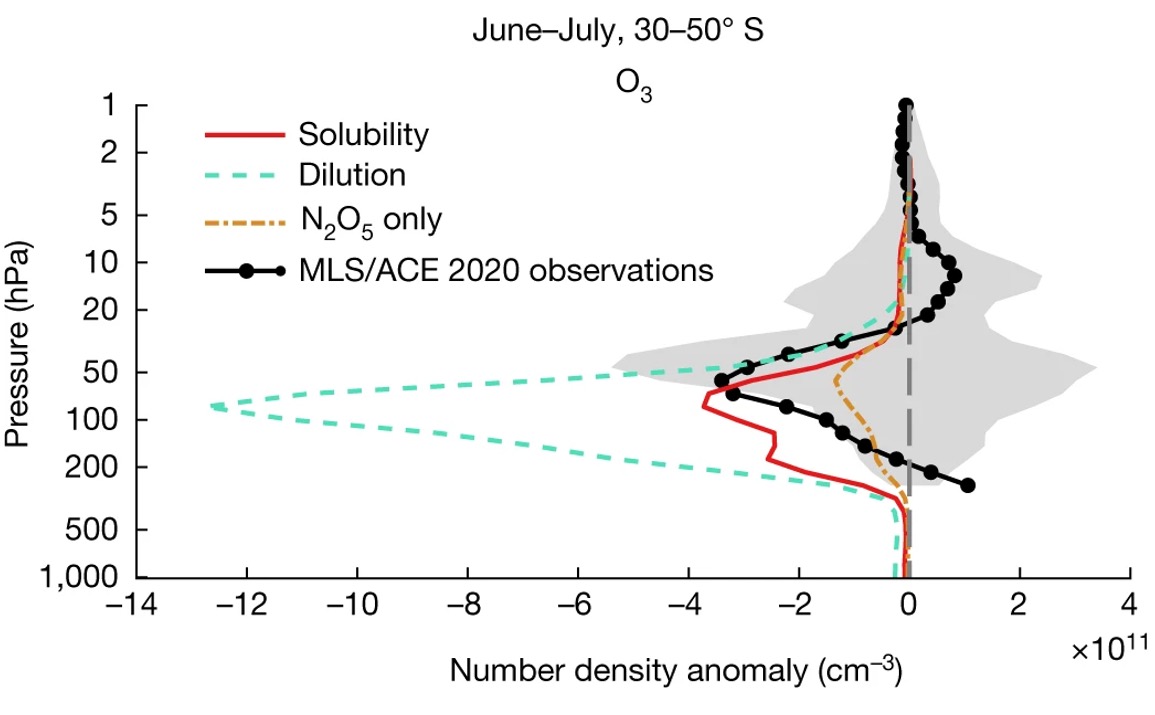 Chlorine activation and enhanced ozone depletion induced by wildfire aerosolSusan Solomon, Kane Stone, Pengfei Yu, D. M. Murphy, Doug Kinnison, A. R. Ravishankara, and Peidong WangNature, 2023
Chlorine activation and enhanced ozone depletion induced by wildfire aerosolSusan Solomon, Kane Stone, Pengfei Yu, D. M. Murphy, Doug Kinnison, A. R. Ravishankara, and Peidong WangNature, 2023Remarkable perturbations in the stratospheric abundances of chlorine species and ozone were observed over Southern Hemisphere mid-latitudes following the 2020 Australian wildfires. These changes in atmospheric chemical composition suggest that wildfire aerosols affect stratospheric chlorine and ozone depletion chemistry. Here we propose that wildfire aerosol containing a mixture of oxidized organics and sulfate increases hydrochloric acid solubility and associated heterogeneous reaction rates, activating reactive chlorine species and enhancing ozone loss rates at relatively warm stratospheric temperatures. We test our hypothesis by comparing atmospheric observations to model simulations that include the proposed mechanism. Modelled changes in 2020 hydrochloric acid, chlorine nitrate and hypochlorous acid abundances are in good agreement with observations. Our results indicate that wildfire aerosol chemistry, although not accounting for the record duration of the 2020 Antarctic ozone hole, does yield an increase in its area and a 3–5% depletion of southern mid-latitude total column ozone. These findings increase concern that more frequent and intense wildfires could delay ozone recovery in a warming world.
@article{solomon_chlorine_2023, title = {Chlorine activation and enhanced ozone depletion induced by wildfire aerosol}, volume = {615}, issn = {1476-4687}, number = {7951}, journal = {Nature}, author = {Solomon, Susan and Stone, Kane and Yu, Pengfei and Murphy, D. M. and Kinnison, Doug and Ravishankara, A. R. and Wang, Peidong}, year = {2023}, pages = {259--264}, }
2022
- JAMES
 Non-Local Parameterization of Atmospheric Subgrid Processes With Neural NetworksPeidong Wang, Janni Yuval, and Paul A. O’GormanJournal of Advances in Modeling Earth Systems, 2022
Non-Local Parameterization of Atmospheric Subgrid Processes With Neural NetworksPeidong Wang, Janni Yuval, and Paul A. O’GormanJournal of Advances in Modeling Earth Systems, 2022Subgrid processes in global climate models are represented by parameterizations which are a major source of uncertainties in simulations of climate. In recent years, it has been suggested that machine-learning (ML) parameterizations based on high-resolution model output data could be superior to traditional parameterizations. Currently, both traditional and ML parameterizations of subgrid processes in the atmosphere are based on a single-column approach, which only use information from single atmospheric columns. However, single-column parameterizations might not be ideal since certain atmospheric phenomena, such as organized convective systems, can cross multiple grid boxes and involve slantwise circulations that are not purely vertical. Here we train neural networks (NNs) using non-local inputs spanning over 3 × 3 columns of inputs. We find that including the non-local inputs improves the offline prediction of a range of subgrid processes. The improvement is especially notable for subgrid momentum transport and for atmospheric conditions associated with mid-latitude fronts and convective instability. Using an interpretability method, we find that the NN improvements partly rely on using the horizontal wind divergence, and we further show that including the divergence or vertical velocity as a separate input substantially improves offline performance. However, non-local winds continue to be useful inputs for parameterizating subgrid momentum transport even when the vertical velocity is included as an input. Overall, our results imply that the use of non-local variables and the vertical velocity as inputs could improve the performance of ML parameterizations, and the use of these inputs should be tested in online simulations in future work.
@article{wang_non-local_2022, title = {Non-{Local} {Parameterization} of {Atmospheric} {Subgrid} {Processes} {With} {Neural} {Networks}}, volume = {14}, copyright = {All rights reserved}, issn = {1942-2466}, language = {en}, number = {10}, urldate = {2024-08-17}, journal = {Journal of Advances in Modeling Earth Systems}, author = {Wang, Peidong and Yuval, Janni and O’Gorman, Paul A.}, year = {2022}, pages = {e2022MS002984}, } - Remote Sens.
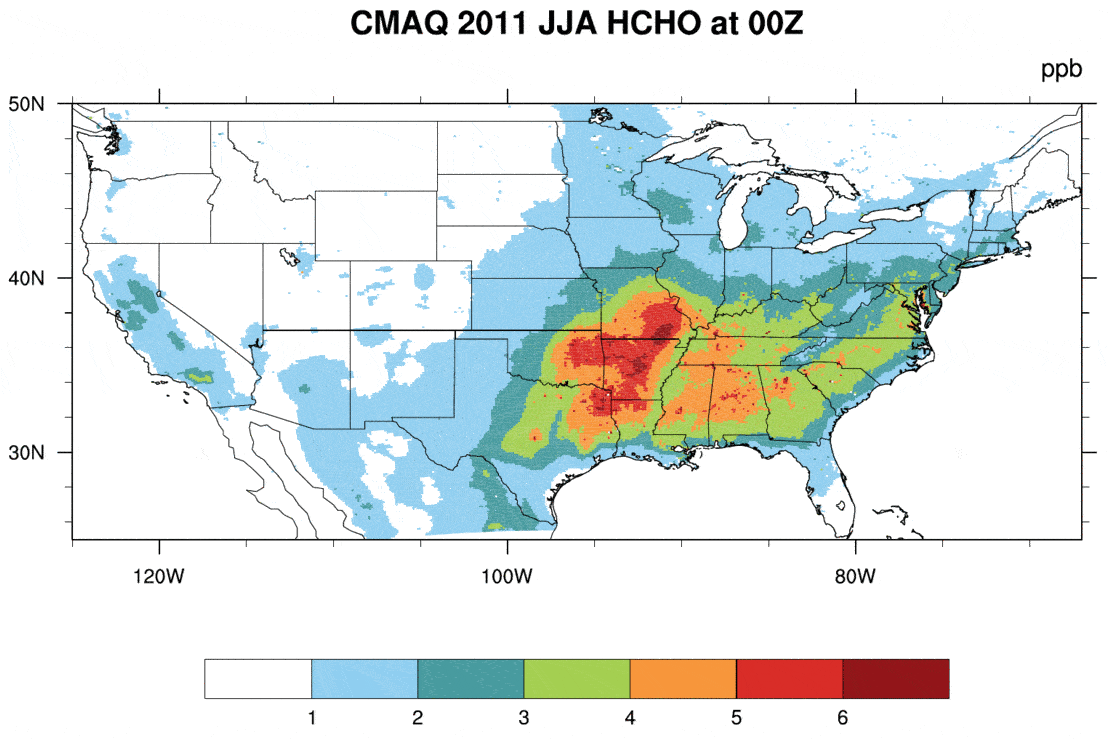 Ambient Formaldehyde over the United States from Ground-Based (AQS) and Satellite (OMI) ObservationsPeidong Wang, Tracey Holloway, Matilyn Bindl, Monica Harkey, and Isabelle De SmedtRemote Sensing, 2022
Ambient Formaldehyde over the United States from Ground-Based (AQS) and Satellite (OMI) ObservationsPeidong Wang, Tracey Holloway, Matilyn Bindl, Monica Harkey, and Isabelle De SmedtRemote Sensing, 2022This study evaluates formaldehyde (HCHO) over the U.S. from 2006 to 2015 by comparing ground monitor data from the Air Quality System (AQS) and a satellite retrieval from the Ozone Monitoring Instrument (OMI). Our comparison focuses on the utility of satellite data to inform patterns, trends, and processes of ground-based HCHO across the U.S. We find that cities with higher levels of biogenic volatile organic compound (BVOC) emissions, including primary HCHO, exhibit larger HCHO diurnal amplitudes in surface observations. These differences in hour-to-hour variability in surface HCHO suggests that satellite agreement with ground-based data may depend on the distribution of emission sources. On a seasonal basis, OMI exhibits the highest correlation with AQS in summer and the lowest correlation in winter. The ratios of HCHO in summer versus other seasons show pronounced seasonal variability in OMI, likely due to seasonal changes in the vertical HCHO distribution. The seasonal variability in HCHO from satellite is more pronounced than at the surface, with seasonal variability 20–100% larger in satellite than surface observations. The seasonal variability also has a latitude dependency, with more variability in higher latitude regions. OMI agrees with AQS on the interannual variability in certain periods, whereas AQS and OMI do not show a consistent decadal trend. This is possibly due to a rather large interannual variability in HCHO, which makes the small decadal drift less significant. Temperature also explains part of the interannual variabilities. Small temperature variations in the western U.S. are reflected with more quiescent HCHO interannual variability in that region. The decrease in summertime HCHO in the southeast U.S. could also be partially explained by a small and negative trend in local temperatures.
@article{wang_ambient_2022, title = {Ambient {Formaldehyde} over the {United} {States} from {Ground}-{Based} ({AQS}) and {Satellite} ({OMI}) {Observations}}, volume = {14}, issn = {2072-4292}, number = {9}, journal = {Remote Sensing}, author = {Wang, Peidong and Holloway, Tracey and Bindl, Matilyn and Harkey, Monica and De Smedt, Isabelle}, year = {2022}, keywords = {annual, formaldehyde, monitor, OMI, satellite, seasonal, temperature, trend}, }
2021
- NeurIPS
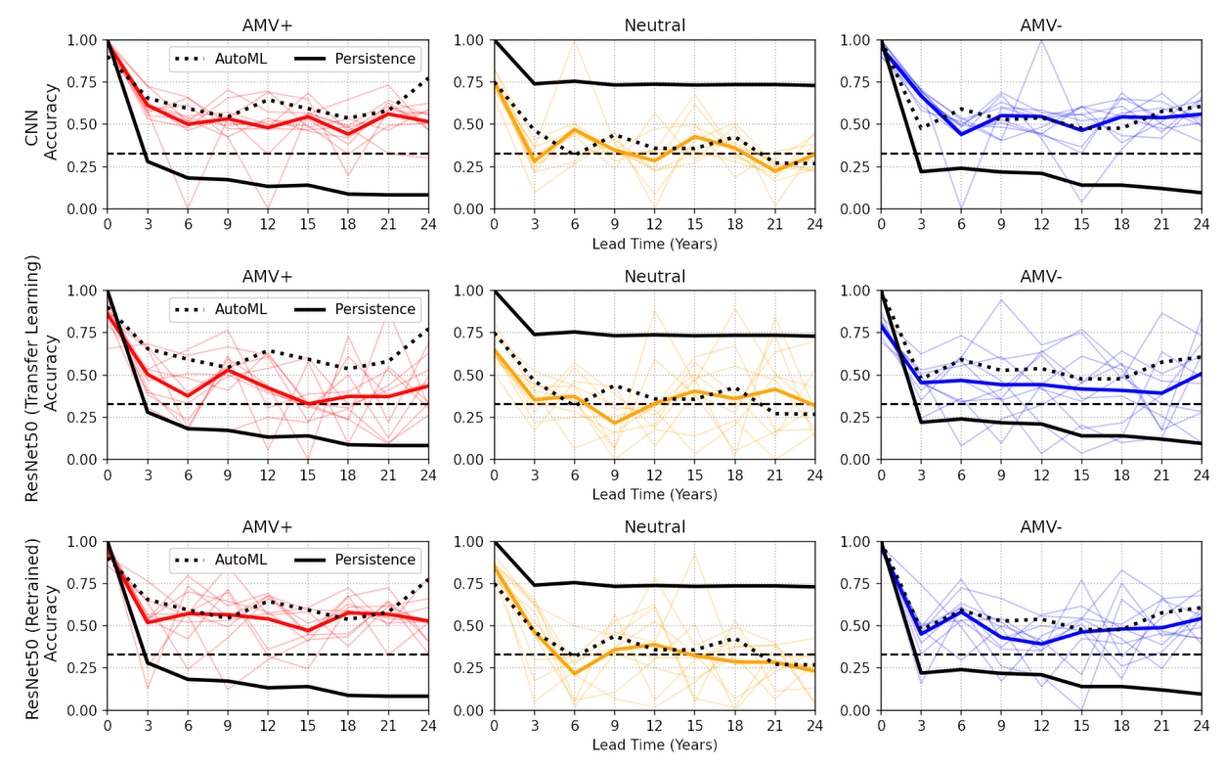 Predicting Atlantic Multidecadal VariabilityGlenn Liu, Peidong Wang, Matthew Beveridge, Young-Oh Kwon, and Iddo DroriIn NeurIPS 2021 Workshop on Tackling Climate Change with Machine Learning, 2021
Predicting Atlantic Multidecadal VariabilityGlenn Liu, Peidong Wang, Matthew Beveridge, Young-Oh Kwon, and Iddo DroriIn NeurIPS 2021 Workshop on Tackling Climate Change with Machine Learning, 2021Atlantic Multidecadal Variability (AMV) describes variations of North Atlantic sea surface temperature with a typical cycle of between 60 and 70 years. AMV strongly impacts local climate over North America and Europe, therefore prediction of AMV, especially the extreme values, is of great societal utility for understanding and responding to regional climate change. This work tests multiple machine learning models to improve the state of AMV prediction from maps of sea surface temperature, salinity, and sea level pressure in the North Atlantic region. We use data from the Community Earth System Model 1 Large Ensemble Project, a state-of-the-art climate model with 3,440 years of data. Our results demonstrate that all of the models we use outperform the traditional persistence forecast baseline. Predicting the AMV is important for identifying future extreme temperatures and precipitation, as well as hurricane activity, in Europe and North America up to 25 years in advance.
@inproceedings{liu2021predicting, title = {Predicting Atlantic Multidecadal Variability}, author = {Liu, Glenn and Wang, Peidong and Beveridge, Matthew and Kwon, Young-Oh and Drori, Iddo}, booktitle = {NeurIPS 2021 Workshop on Tackling Climate Change with Machine Learning}, year = {2021}, } - GRL
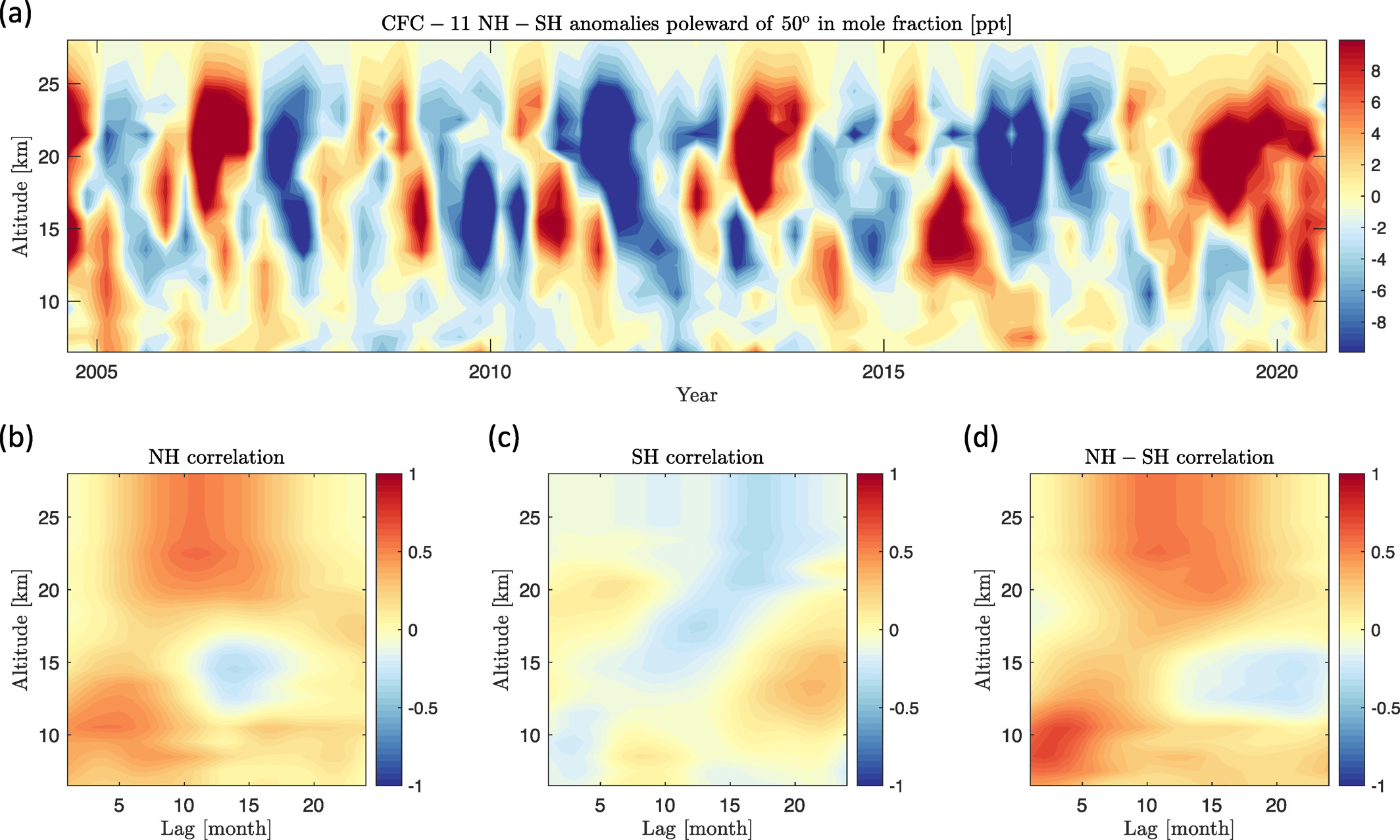 Quantifying the Imprints of Stratospheric Contributions to Interhemispheric Differences in Tropospheric CFC-11, CFC-12, and N2O AbundancesMegan Lickley, Susan Solomon, Doug Kinnison, Paul Krummel, Jens Mühle, Simon O’Doherty, Ronald Prinn, and 5 more authorsGeophysical Research Letters, 2021
Quantifying the Imprints of Stratospheric Contributions to Interhemispheric Differences in Tropospheric CFC-11, CFC-12, and N2O AbundancesMegan Lickley, Susan Solomon, Doug Kinnison, Paul Krummel, Jens Mühle, Simon O’Doherty, Ronald Prinn, and 5 more authorsGeophysical Research Letters, 2021Abstract For trace gases destroyed in the stratosphere, mass flux across the tropopause can substantially influence observed surface hemispheric differences (NH-SH). Here, we quantify associations between observed stratospheric and tropospheric NH-SH growth rate anomalies of CFC-11, CFC-12, and N2O. We employ a chemistry climate model along with satellite and global surface station observations. Our model explains 60% of observed N2O NH-SH growth rate variability from 2005 to 2019, compared to 30% for CFC-11% and 40% for CFC-12, supporting evidence that unexpected anthropogenic emissions caused sustained positive NH-SH anomalies in these CFCs from 2012 to 2017. Between 2012 and 2015, the observed CFC-11 NH-SH difference grew by 1.7 ppt; our model explains 0.5 ± 0.1 ppt of this growth, but not the duration. Our model suggests that in the absence of further emission anomalies, new NH-SH positive tracer anomalies should have occurred in 2020, and predicts small negative anomalies in 2021.
@article{lickley_quantifying_2021, title = {Quantifying the {Imprints} of {Stratospheric} {Contributions} to {Interhemispheric} {Differences} in {Tropospheric} {CFC}-11, {CFC}-12, and {N2O} {Abundances}}, volume = {48}, issn = {0094-8276}, number = {15}, urldate = {2024-08-17}, journal = {Geophysical Research Letters}, author = {Lickley, Megan and Solomon, Susan and Kinnison, Doug and Krummel, Paul and Mühle, Jens and O'Doherty, Simon and Prinn, Ronald and Rigby, Matthew and Stone, Kane A. and Wang, Peidong and Weiss, Ray and Young, Dickon}, year = {2021}, pages = {e2021GL093700}, } - PNAS
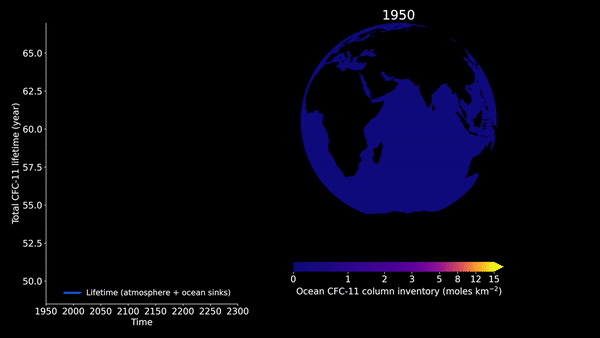 On the effects of the ocean on atmospheric CFC-11 lifetimes and emissionsPeidong Wang, Jeffery R. Scott, Susan Solomon, John Marshall, Andrew R. Babbin, Megan Lickley, David W. J. Thompson, and 3 more authorsProceedings of the National Academy of Sciences, 2021
On the effects of the ocean on atmospheric CFC-11 lifetimes and emissionsPeidong Wang, Jeffery R. Scott, Susan Solomon, John Marshall, Andrew R. Babbin, Megan Lickley, David W. J. Thompson, and 3 more authorsProceedings of the National Academy of Sciences, 2021Manufactured CFC-11 is depleting the Antarctic ozone layer. CFC production has been strictly controlled by the Montreal Protocol, but emission estimates are very sensitive to choices of lifetimes, which are often assumed as constant over time. We employ a hierarchy of models to study the effect of the ocean on the time-dependent uptake and release of atmospheric CFC-11. The ocean is a sink for CFC-11 and significantly affects its total lifetime and hence the emission inferred from concentration data of past decades. This has not been explicitly included in international ozone assessments. We show that, as anthropogenic production ceases, ocean fluxes become more important, suggesting a need for further studies with high-resolution global models linking atmospheric chemistry and ocean processes. The ocean is a reservoir for CFC-11, a major ozone-depleting chemical. Anthropogenic production of CFC-11 dramatically decreased in the 1990s under the Montreal Protocol, which stipulated a global phase out of production by 2010. However, studies raise questions about current overall emission levels and indicate unexpected increases of CFC-11 emissions of about 10 Gg/yr after 2013 (based upon measured atmospheric concentrations and an assumed atmospheric lifetime). These findings heighten the need to understand processes that could affect the CFC-11 lifetime, including ocean fluxes. We evaluate how ocean uptake and release through 2300 affects CFC-11 lifetimes, emission estimates, and the long-term return of CFC-11 from the ocean reservoir. We show that ocean uptake yields a shorter total lifetime and larger inferred emission of atmospheric CFC-11 from 1930 to 2075 compared to estimates using only atmospheric processes. Ocean flux changes over time result in small but not completely negligible effects on the calculated unexpected emissions change (decreasing it by 0.4 ± 0.3 Gg/yr). Moreover, it is expected that the ocean will eventually become a source of CFC-11, increasing its total lifetime thereafter. Ocean outgassing should produce detectable increases in global atmospheric CFC-11 abundances by the mid-2100s, with emission of around 0.5 Gg/yr; this should not be confused with illicit production at that time. An illustrative model projection suggests that climate change is expected to make the ocean a weaker reservoir for CFC-11, advancing the detectable change in the global atmospheric mixing ratio by about 5 yr.
@article{wang_effects_2021, title = {On the effects of the ocean on atmospheric {CFC}-11 lifetimes and emissions}, volume = {118}, number = {12}, urldate = {2024-08-17}, journal = {Proceedings of the National Academy of Sciences}, author = {Wang, Peidong and Scott, Jeffery R. and Solomon, Susan and Marshall, John and Babbin, Andrew R. and Lickley, Megan and Thompson, David W. J. and DeVries, Timothy and Liang, Qing and Prinn, Ronald G.}, year = {2021}, pages = {e2021528118}, }
Thesis
2025
- Understanding Drivers of Stratospheric Ozone Change and Fingerprinting its RecoveryPeidong WangMassachusetts Institute of Technology, May 2025
Stratospheric ozone serves as Earth’s natural protective layer, shielding the surface from harmful ultraviolet radiation. The discovery of the Antarctic ozone “hole” in the late 1980s raised significant societal and scientific concern, prompting the rapid regulation of ozonedepleting substances (ODSs) under international treaties. While the signs of ozone recovery have begun, new challenges continue to arise. This thesis investigates three critical factors driving stratospheric ozone changes and influencing the detection of ozone recovery: (1) ODS emissions, (2) chemical chlorine processes, and (3) internal climate variability. With ODS emissions being regulated under the Montreal Protocol and studies now focusing on illicit new production on the order of tens of gigagrams per year, the ocean’s role as both a natural source and sink of ODSs becomes increasingly important. However, these processes have often been overlooked or highly simplified in past ozone assessments. Using a hierarchy of models, from simple box models to global ocean general circulation models, I quantified the ocean’s uptake and release of various ODSs. Chapter 2 examines the ocean’s uptake of chlorofluorocarbons (CFCs), particularly emphasizing its influence on recent illicit CFC emissions estimation. Chapter 3 extends this analysis to include ocean uptake and potential microbial degradation processes, evaluating their effects on emission estimates for various hydrochlorofluorocarbons (HCFCs) and hydrofluorocarbons (HFCs), which are chemical constituents that have been used to replace CFCs. Once these man-made ODSs reach the stratosphere, they are photolyzed to chlorine reservoir species (e.g., HCl and ClONO2), which, through heterogeneous reactions, can transform into reactive chlorine that depletes ozone. While heterogeneous chlorine activation on volcanic ash is well understood, the unprecedented 2020 Australian wildfires raised new questions about chemical processes on smoke particles. This knowledge gap existed because only a few wildfires had injected significant amounts of smoke particles into the stratosphere during the satellite era. Leveraging over 30 years of satellite data, I separated chemical and dynamic processes affecting chlorine reservoir species to quantify chemical chlorine activation across different aerosol types. In Chapter 4, I developed a new approach to quantitatively estimate the onset temperature for chemical chlorine activation after the 2020 Australian wildfire using satellite observations. Chapter 5 applies this method to compare the impact of chemical chlorine activation from two independent wildfire events with that from a series of volcanic eruptions of varying magnitudes. Despite emerging challenges such as illicit emissions and recent wildfires and volcanic eruptions, advancements in observational records, our understanding of ozone chemistry, and computational power have significantly enhanced our ability to quantitatively detect and attribute stratospheric ozone changes. In Chapter 6, I applied a pattern-based “fingerprinting” technique to quantitatively separate the contributions of ODS forcing from other external forcings and internal variabilities in satellite observations. This analysis shows that Antarctic ozone increases cannot be explained by climate internal variability alone, providing strong confidence that ozone recovery is underway, primarily driven by human efforts to reduce ODS emissions.
